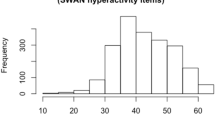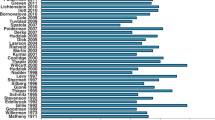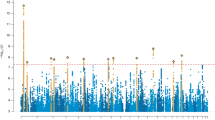Abstract
There has been considerable controversy over the nosology of hyperactivity and attention deficit hyperactivity disorder (ADHD). There have been suggestions that genetic influences may play a role in the origins of individual differences on this dimension or dimensions of behavior and that an understanding of the significance of genetic factors might help to clarify the classification of these disorders. Multiple regression is used to analyze data from a sample of 91 pairs of identical twins and 105 pairs of same sex fraternal twins. The heritability of extreme group membership (h2 g =0.75) was significant for activity rated by the mother. The heritability for one of the measures of attention deficit was also significant (h2 g =0.76). The results are consistent with a significant genetic contribution to individual differences in activity levels and attention abilities.
Similar content being viewed by others
References
Cohen, D. J., Dibble, E., Grawe, J. M., and Pollin, W. (1975). Reliably separating identical from fraternal twins.Arch. Gen. Psychiat. 32:1371–1375.
DeFries, J. C., and Fulker, D. W. (1985). Multiple regression analysis of twin data.Behav. Genet. 15:467–473.
DeFries, J. C., and Fulker, D. W. (1988). Multiple regression analysis of twin data: Etiology of deviant scores versus individual differences.Acta Genet. Med. Gemellol. 37:1–13.
DeFries, J. C., Fulker, D. W., and LaBuda, M. C. (1987). Evidence for a genetic aetiology in reading disability of twins.Nature 329:537–539.
Egger, J., Carter, C. M., Graham, P. J., Gumley, D., and Soothill, J. F. (1985). Controlled trial of oligoantigenic treatment in the hyperkinetic syndrome.Lancet 1:540–545.
Goodman, R., and Stevenson, J. (1989a). A twin study of hyperactivity. I. An examination of hyperactivity scores and categories derived from the Rutter teacher and parent questionnaires.J. Child Psychol. Psychiat. 30:671–689.
Goodman, R., and Stevenson, J. (1989b). A twin study of hyperactivity. II. The aetiological role of genes, family relationships and perinatal adversity.J. Child Psychol. Psychiat. 30:691–709.
Graham, P., and Stevenson, J. (1985). A twin study of genetic influences on behavioral deviance.J. Am. Acad. Child Psychiat. 24:23–41.
Hodges, J., and Tizard, B. (1989). IQ and behavioral adjustment of ex-institutional adolescents.J. Child Psychol. Psychiat. 30:53–75.
Kaufman, A. S. (1979).Intelligent Testing with the WISC-R, Wiley, New York.
Sandberg, S. (1986). Overactivity: Behaviour or syndrome?. In Taylor, E. (ed.),The Overactive Child, Mac Keith Press, London, pp. 41–73.
Schachar, R., Rutter, M., and Smith, A. (1981). The characteristics of situationally and pervasively hyperactive children: Implications for syndrome definition.J. Child Psychol. Psychiat. 22:375–392.
Spohr, H.-L., and Steinhausen, H.-C. (1987). Follow-up studies of children with fetal alcohol syndrome.Neuropediatrics 18:13–17.
Stevenson, J., Graham, P., Fredman, G., and McLoughlin, V. (1987). A twin study of genetic influences on reading and spelling ability and disability.J. Child Psychol. Psychiat. 28:229–247.
Taylor, E. (1986a). The causes and development of hyperactivity. In Taylor, E. (ed.),The Overactive Child, Mac Keith Press, London, pp. 1–19.
Taylor, E. (1986b). Attention deficit. In Taylor, E. (ed.),The Overactive Child, Mac Keith Press, London, pp. 73–106.
Thompson, J. S., and Thompson, M. W. (1986).Genetics in Medicine, W. B. Saunders, Philadelphia.
Wechsler, D. I. (1974).Examiner's Manual: Wechsler Intelligence Scale for Children-Revised, Psychological Corp., New York.
Willerman, L. (1973). Activity level and hyperactivity in twins.Child Dev. 44:288–293.
Author information
Authors and Affiliations
Additional information
This research was supported by a grant from the Medical Research Council to Professor Philip Graham, Institute of Child Health, London, and myself.
Rights and permissions
About this article
Cite this article
Stevenson, J. Evidence for a genetic etiology in hyperactivity in children. Behav Genet 22, 337–344 (1992). https://doi.org/10.1007/BF01066665
Received:
Accepted:
Issue Date:
DOI: https://doi.org/10.1007/BF01066665




